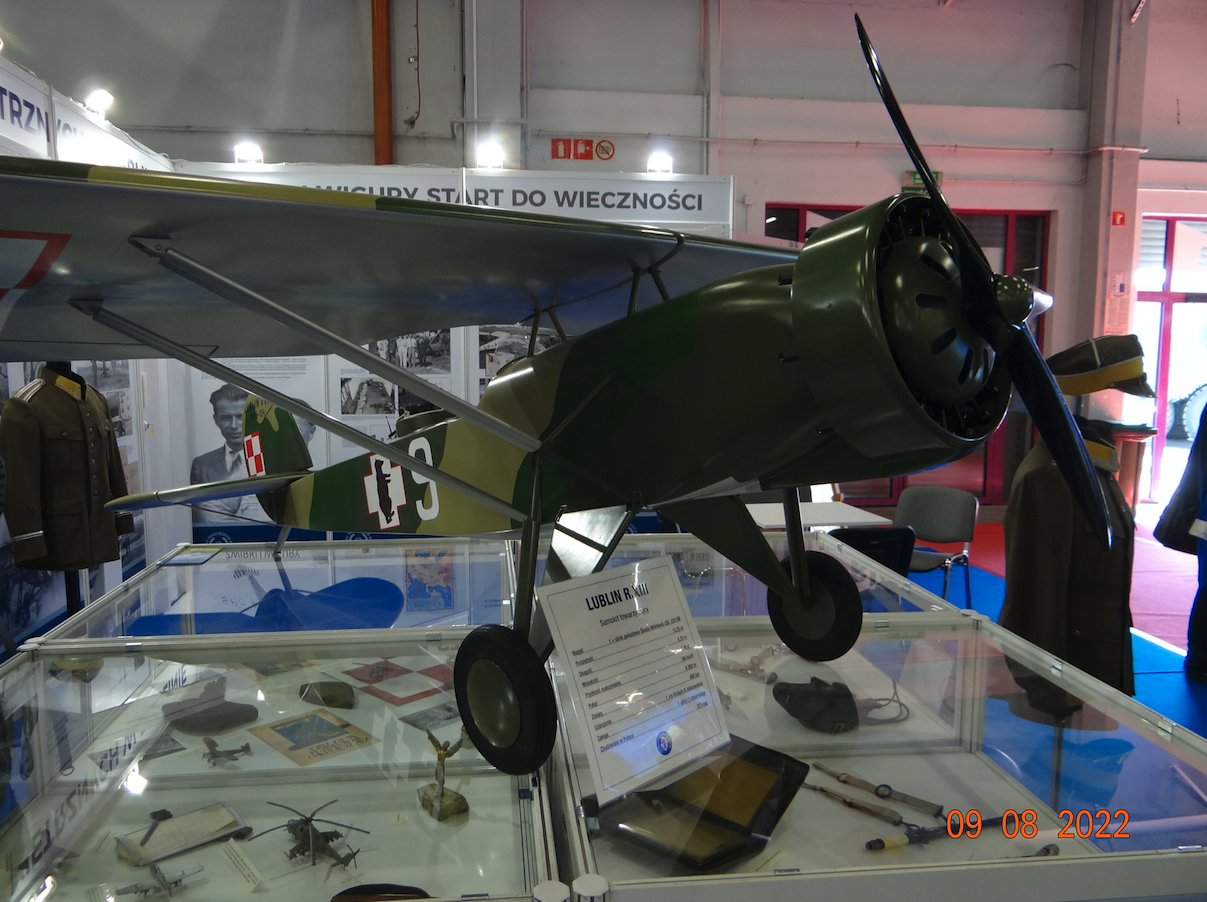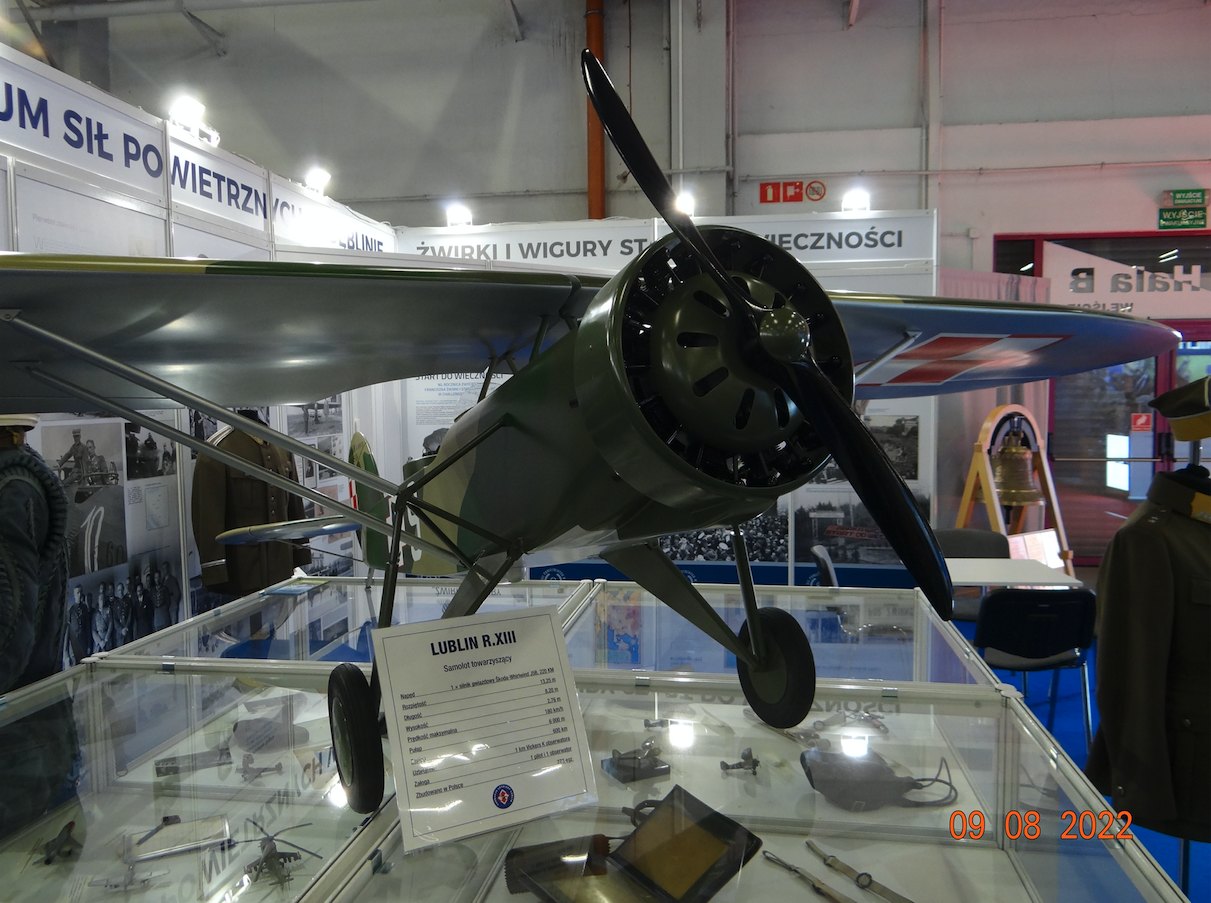Lublin 2022-09-09
E. Plage and T. Laśkiewicz Mechanical Works in Lublin.
Lublin R-XIII.
The Lublin R-XIII plane was a military, two-seater, the so-called accompanying plane, intended for observation, artillery fire correction, communication tasks, and even for air training. It was built in a classic layout, as a high-wing, powered by one engine.
The Emil Plage and Teofil Laśkiewicz Mechanical Works in Lublin are undoubtedly the first Polish Aviation Works. It has been producing airplanes since 1921. From 1928, it produced its own aircraft designs, and after nationalization, it built planes under the name of Lublin. In 1935, the factory was nationalized. In 1939, after the Germans and Soviets attacked the Republic of Poland, the factory was liquidated. In the halls and hangars of the factory, the Germans arranged warehouses for stolen gold, silver, jewelry, and money, which they then sent back to the territory of the German empire.
Aircraft production in Lublin.
In 1918, the rebirth of the Republic of Poland opened up new opportunities for the plant in Lublin. Teofil Laśkiewicz, at the urging of eng. Kazimierz Arciszewski, asked the air force inspector for permission to establish an aviation department. A positive answer came on February 14, 1920. On February 17, 1920, the Plant signed an agreement with the Military Aviation for serial production under the license of Italian aircraft; fighter Ansaldo A-1 "Balila" (200 copies) and reconnaissance bomber Ansaldo A-300 (100 copies). The contract was for 300 aircraft.
More land was purchased for the new production halls. The area of the plant increased from slightly more than 1 ha to 13-14 ha. There is 10,000 m2 under the roof. In 1921, the factory employed about 500 people. Address; Lublin, 26 Fabryczna Street. The first Ansaldo A-300 aircraft was flown on June 15, 1921. According to a common opinion, popularized during the People’s Republic of Poland, the quality of the aircraft was low. There have been several disasters. This resulted in a reduction in the order. In individual years they were built; 1921 – 14 machines, 1922 – 22 machines, 1923 – 60 machines, 1924 – until production is stopped, 36 machines.The fact is; that in 1921, while performing the evolution, the pilot Adam Haber-Włyński, pilot Adam Haber-Włyński, died, in 1922, as a result of tearing off his wings, ensign J. Ryba and sergeant W. Górski were killed. In 1924, an investigation was conducted and a report was drawn up which concluded that 18 of the 110 planes had been injured, but only one was the plant’s fault. The blame must be placed on the poor and faulty Italian engines. The Italian airframes themselves had design flaws. They were adapted to operation in a dry climate and had no protection against moisture. The adhesives used were not resistant to significant humidity and low temperatures, which was initially not taken into account. As a result, Lublin planes did not enjoy a good reputation.
This report contributed to the fact that in 1924, the plant received an order for the licensed production of French Potez XV liners, of which 100 were produced, in the period 1925-1926. Then, the plants were commissioned to license production of Potez XXV linear planes, of which 150 were produced, in the period 1928 – 1931. Both types of aircraft were manufactured in parallel in Lublin and Biała Podlaska at the PWS – Podlaska Wytwórnia Samolotów plant. In the period 1929 – 1930, the plant produced, under the license of Fokker, 11 Fokker F-VIIB / 3m passenger planes and another 20 in a self-developed bomb version.
Own construction of plants in Lublin.
In the mid-20s, the management of the plant changed. In 1927, Eng. Jerzy Rudlicki, a graduate of the Higher Aviation School in Paris. In addition to license production, the plant then began to develop its own designs under the direction of Eng. Jerzy Rudlicki. The construction team also included Eng. Jerzy Dąbrowski. The planes of the Plage and Laśkiewicz plants were given the name of Lublin and the designation "R" followed by Roman numerals. The first of its own design was the single-engine Lublin R-VIII biplane biplane, flown in 1928 and produced in the number of 6, in the period 1928 – 1930, of which 3 were then converted into seaplanes and used by Polish Maritime Aviation.
In 1929, a prototype of the R-IX passenger plane (based on the R-VIII design) was flown, and in 1930 it was developed into the R-XI passenger plane. The design was not ordered by the airlines.
Another design was the single-engine Lublin R-X high-wing aircraft, flown in 1929, which won the competition for a liaison plane for Polish Aviation, defeating the PZL Ł.2 plane. It was ordered in the number of only 7 copies. On its basis, Eng. Jerzy Rudlicki designed the R-XIV training plane, the Lublin R-XIII version of which became the basic observation plane of the Polish Aviation in 1933 – 1939. Lublin R-XIV was built in 1930 – 1931, in the number of 15 aircraft, and Lublin R-XIII in 1932 – 1935, in the number of 223 copies. A further 50 were built after the plant was nationalized. In 1930, the Lublin R-XII sports plane was tested, but it was not successful and did not enter production.
Another design of the passenger plane was the Lublin R. XVI, from 1932, which was also not purchased by LOT Polish Airlines. On its basis, in the period 1933-1935, 6 R-XVI-b planes in the sanitary version were built. The last construction of the plant was the Lublin R-XX heavy seaplane twin-engine, flew in 1935, which also did not enter production. In addition to the constructed structures, the plant office also developed several other projects that were not implemented.
Lublin R-XIII.
Lublin R-XIII / R-XIV – the first flight was performed by the R-XIV plane in June 1930. The plane is a development of the R-X plane. The military ordered 15 copies. In July 1931, the plane underwent tests. During one flight, the steering rod pin was sheared off. The pilot jumped out with a parachute, and the plane landed correctly, stopping in the ditch. However, the constructor decided that the symbol R-XIV was unlucky and changed the designation to R-XIII, which was initially omitted.
The R-XIII aircraft entered mass production. A total of 273 aircraft of all versions were produced. The following versions were built: R-XIII A (30 copies, 1931), R-XIII B (20 copies, 1932), R-XIII C (48 copies, 1933), R-XIII D (95 copies, 1933) ), R-XIII E (prototype with 360 PS Gnôme-Rhône 7K Titan engine, 1934), R-XIII F (58 units, 1934), R-XIII bis / hydro (4 units, 1931), R- XIII ter / hydro (10 copies, 1934), R-XIII G (6 copies, 1934), R-XIII Dr. "Blue Bird" rally plane (1 copy, 1933), R-XIII t two-wheeler aircraft made of conversion of existing aircraft (8 copies).
Data of T-T Lublin R-XIII:
Span 13.25 m. Length 8.20 m. Height 2.76 m. Bearing area 24.5 m2. Curb weight 800 kg. Gross weight is 1,290 kg. Top speed 180 km / h. Service ceiling 4,100 m. Range 600 km. The plane was armed with one mobile machine gun operated by an observer. 220 HP (162 kW) radial engine.
Written by Karol Placha Hetman


